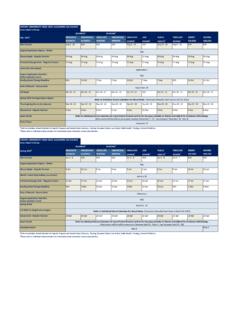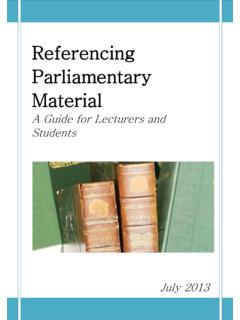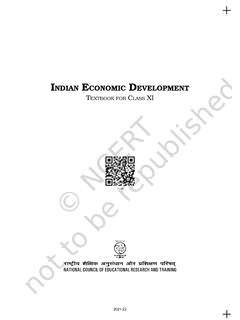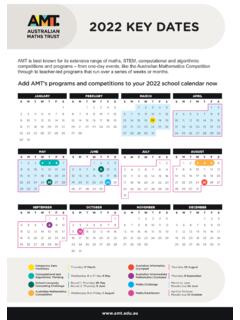Transcription of RAILWAY - ARPWE
1 SATISH CHANDRAP rofessor, Department of Civil Engineering,Indian Institute of Technology AGARWALR etired Chief Engineer,Northern RailwaysRAILWAYENGINEERING13 YMCA Library Building, Jai Singh Road, New Delhi 110001 oxford university Press is a department of the university of furthers the university s objective of excellence in research, scholarship,and education by publishing worldwide inOxford New YorkAuckland Cape Town Dar es Salaam Hong Kong KarachiKuala Lumpur Madrid Melbourne Mexico City NairobiNew Delhi Shanghai Taipei TorontoWith offices inArgentina Austria Brazil Chile Czech Republic France GreeceGuatemala Hungary Italy Japan Poland Portugal SingaporeSouth Korea Switzerland Thailand Turkey Ukraine VietnamOxford is a registered trade mark of oxford university Pressin the UK and in certain other in Indiaby oxford university Press oxford university
2 Press 2007 The moral rights of the author have been right oxford university Press (maker)First published 2007 All rights reserved. No part of this publication may be reproduced,stored in a retrieval system, or transmitted, in any form or by any means,without the prior permission in writing of oxford university Press,or as expressly permitted by law, or under terms agreed with the appropriatereprographics rights organization. Enquiries concerning reproductionoutside the scope of the above should be sent to the Rights Department, oxford university Press, at the address must not circulate this book in any other binding or coverand you must impose this same condition on any : 978-0-19-568779-8 ISBN-10.
3 0-19-568779-5 Typeset in Times Romanby Le Studio Graphique, Gurgaon 122001 Printed in India by Ram Book Binding House, New Delhi 110020and published by oxford university PressYMCA Library Building, Jai Singh Road, New Delhi 110001 RAILWAYENGINEERINGP refaceiiiPrefaceThere have been major technological developments in railways around the world in therecent past to meet the challenges of heavier traffic and higher speeds. In Indian Railwaysespecially, the track structure has been modernized in a big way in the last three welded rails, concrete sleepers, and elastic fastenings have been used on high-speed routes to provide stable and resilient structures.
4 Metro railways are also beingintroduced in metropolitan cities to ease the problem of congestion on roads. Diesel andelectric locomotives, which have superior performance capabilities, have replaced steamlocomotives. In addition, modern signalling, automatic warning, and centralized trafficcontrol systems are being adopted to ensure safety and maximum utilization of is very important for engineering students and new entrants into the field of railwaysto be aware of not only the fundamentals of RAILWAY engineering but also latestdevelopments with regard to RAILWAY tracks, locomotives and rolling stock, signallingand interlocking, the BookThis book deals with all aspects of RAILWAY engineering, from fundamental concepts tomodern technological developments.
5 With special focus on Indian Railways. It is anamalgamation of the vast experiences of the authors of teaching the subject as well asof serving in Indian Railways. The text presents the theories and field practices as wellas the modern techniques in and CoverageThe book treats the theoretical and practical aspects of the subject exhaustively andincorporates the latest provisions adopted by Indian Railways (IR).Chapter 1 presents a historical account of railways around the world with specialfocus on the important features of IR. Chapter 2 discusses the various gauges adoptedby IR and the problems associated with multigauge systems.
6 Chapter 3 explains thefactors affecting track alignment. Chapter 4 describes the different types of engineeringsurveys required to be undertaken before launching a new RAILWAY project as well as theconstruction of new lines including doubling and gauge conversions. Chapter 5 presentsthe details of track specifications and structures for different gauges on IR. It alsodiscusses the forces acting on a track and the stresses generated in track 6 to 10 describe the various components of a RAILWAY track rails, sleepers,ballast, formation, and fittings and fastenings.
7 It also discusses the recent provisionsadopted by IR with respect to these 11 explains the causes and remedial measures for creep in rails. Chapter 12presents the basic aspects of the geometric design of RAILWAY tracks. Chapter 13 discussesthe detailed design of the horizontal and vertical curves on a RAILWAY line. Chapter 14and 15 elaborate on the various types of track junctions and their designs, layouts ofturnouts, and the factors affecting speed on 16 discusses rail joints and the methods used for welding rail 17 describes the developments in welded RAILWAY tracks including long weldedivPrefacerails (LWRs) and continuous welded rails (CWRs).
8 It also explains the detailed procedurefor laying LWRs and the track specifications for long and short welded rails. Chapter 18describes the calendar system of track maintenance being followed by Indian Railways,which includes the conventional track maintenance operations of through packing,systematic overhauling, and picking up slacks. Chapter 19 details the track drainagesystem, along with the drainage of station platforms, yards, and subsurface 20 describes the modern methods of track maintenance followed by IndianRailways employing track machines.
9 It presents the details of measured shovel packing(MSP) equipment on IR. The chapter also describes Directed Track Maintenance(DTM) IR s annual programme and its future 21 elaborates on the methods of track rehabilitation and the renewal of trackcomponents. It also discusses some new machines used by IR for track renewal. Chapter22 discusses accident and disaster management, which assumes significance because ofgreater emphasis being placed on safety by Indian Railways. Chapter 23 describes levelcrossings and the measures taken to prevent accidents at such crossings.
10 Chapter 24includes the design and maintenance features of locomotives and other rolling 25 provides the details of train resistances and their evaluation. It also definestractive effort and hauling capacity of 26 and 27 include details of station yards and the various equipment usedin RAILWAY stations, respectively. Chapter 28 discusses the construction of new railwaylines, track material required for BG tracks, doubling of RAILWAY lines, and gaugeconversion. Chapter 29 exclusively discusses suburban railways in metropolitan cities,which is the latest trend in the Indian context, so that this subject is fully appreciated bythe readers.




